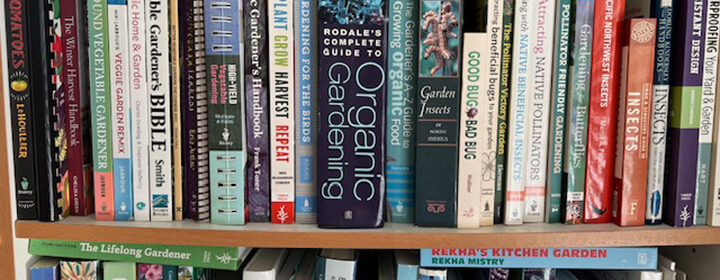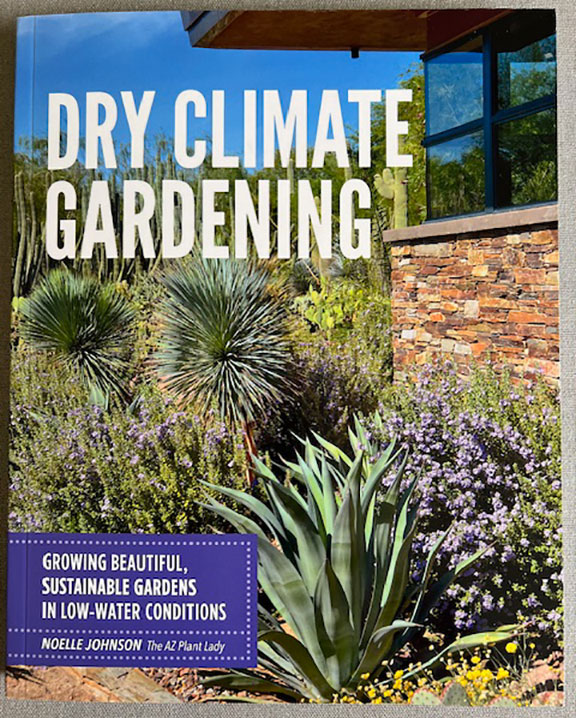Book Review: Dry Climate Gardening

Dry Climate Gardening* by Noelle Johnson (Cool Springs Press, 2023, $28.99)
by Susan Mulvihill
We gardeners all have varying degrees of challenges, right? They might occur while we’re trying to grow our own food or create a pleasing landscape around our home. Those who live in arid or semi-arid climates have a unique set of challenges. But that doesn’t mean a beautiful garden isn’t an option. On the contrary!
I am delighted that my friend and colleague, Noelle Johnson, has written this very useful book. With a business name of AZPlantLady, you can rest assured she knows exactly what she’s talking about.
Dry Climate Gardening focuses on great plant picks that will change your perception of what you can grow in dry conditions. And, of course, many regions within the States and beyond have been further stressed by climate change. That makes this book very timely and informative.
The author presents a realistic approach to this topic. She shares the mistakes she made in the early days of living in a dry climate. And what she has learned over the years to create her own beautiful, thriving garden. What’s more, as a horticulturist and landscape consultant, Noelle knows exactly what she’s talking about.
“The key to a beautiful outdoor space in a dry environment is to avoid common mistakes and embark on a journey of learning how to create, grow and maintain a garden that thrives in a hot, arid climate…. The key to success in a hot, dry land is to learn a new set of guidelines and embrace arid-adapted plants to achieve your goal of a beautiful outdoor space that will shrug off the stress of low humidity, drought, and intense heat.”
Noelle Johnson, “Dry Climate Gardening”
Chapter 1
In chapter one (“Choosing the Right Plants for Hot, Arid Regions”), she advises you to avoid overlooking the needs of the plants you want to grow. It’s so important to do your research before making any plant purchases so you will find a good match specifically for your conditions.
The goal is to choose plants that are well-suited to extreme temperatures and reduced moisture. And you want to go beyond looking only at the hardiness zones each plant will grow in. You also will learn about the adaptations certain plants have developed in order to tolerate temperature extremes, sun exposure and dry conditions.
Chapter 2
Chapter two (“Planting Basics for Dry Regions”) contains Noelle’s tips for getting plants off to the best start possible, including the best time to plant and understanding how moisture moves and is retained within different soil types.
Chapter 3
In chapter three (“Caring for Plants in the Dry Climate Garden”), she covers essential information to help you be successful. These include proper pruning techniques such as best practices, the time to prune, when to use fertilizers, how much and how often to water your plants, how to deal with certain insect pests, and which plants are resistant to deer, rabbits and javelinas. I now realize that I need to count my blessings because we don’t get javelinas in our Eastern Washington garden!
Chapter 4
But wait, there’s so much more useful information in this book. In chapter four (“Dry Climate Garden Design: What Plant Goes Where?”), Noelle discusses important concepts to keep in mind. These include proper plant spacing, giving your plants the right amount of light, and grouping them based on how much water they need. There are even landscape design samples to provide you with ideas and inspiration. She wraps up this packed chapter with tips for growing plants in containers in a dry climate.
Chapter 5
Gardeners in arid and semi-arid climates will especially appreciate chapter five (“Plant List”). In it, you’ll find wonderful profiles of trees, shrubs, groundcovers and perennials, vines, cacti and succulents, and grasses and palms. Each profile includes when they bloom, their mature size, exposure needs, cold tolerance, and where they originated.
There are even charts that list plants for specific settings such as full sun and reflected light, shade, drought tolerance, color gardens and pollinator gardens.
Dry Climate Gardening is such a valuable resource. Noelle Johnson’s experience – both from living in dry climate regions as well as her horticultural background and landscape consultant business – will guide you through the steps it takes to become a successful gardener in these challenging conditions.
* This is an Amazon affiliate link but it will not impact the price you pay.

